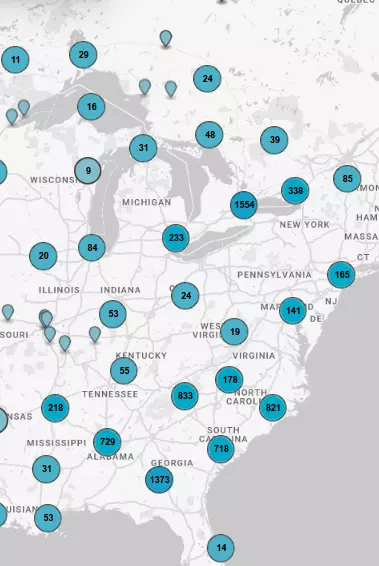Logan's 15th & Blair's 17th A.C. to Decatur
July 19, 1864. Logan´s troops, in "light fighting order" left camp at Henderson´s Mill (.8 mile N.E.) at 5 A.M. & marched to Decatur. They were joined at this point by Blair´s corps which...
- lat34
McPherson's Divergent Line of March
July 17, 1864. At this road-fork (near old Providence Church), the 16th A.C. of the Army of the Tenn enroute from Roswell to Decatur moved by the west fork toward Nancy´s Creek where it...
- lat34
Dodge's & Blair's Columns Separate
July 19, 1864. Blair´s 17th A.C. followed by Dodge´s 16th [US], having camped near Blake´s Mill .6 mi. N. on Old Shallow Ford Rd. the night before, moved S. to this point where their lines of...
- lat34
Site: Henderson's Mill
Some 300 ft N.W. stood the ante and post bellum grist mill owned and operated by Greenville Henderson (1792-1869) and his son Rufus (1823-1872). The flat, left and rt. of this road was the mill...
- lat34
Logan's Corps Moves To Henderson's Mill
July 18, 1864. Logan´s troops having detoured from Shallow Ford Rd. to Browning´s Court House (TUCKER), to co-operate with Garrard´s cav, in the destruction of the Georgia R.R. at Stone...
- lat34
Garrard's Cavalry at Stone Mtn. Depot
July 18, 1864. Garrard´s cavalry division and Lightburn´s 15 A.C. [US] brigade moved from Browning´s Court House (Tucker), to this vicinity and destroyed 2 miles of GA R.R. track,...
- lat34
Garrard & Lightburn to Stone Mountain
The principle object of the wide swing of Federal forces S.E. from Roswell, where they crossed the Chattahoochee, was to cut the Ga. R.R. at & near Stone Mountain, thereby isolating Atlanta from...
- lat34
Browning's Court House
At or near this crossroads stood the J.P. office of Browning´s Militia District No. 572; cited in reports of Federal military operations July, 1864, as Browning´s Court House. July 18. Logan´s...
- lat34
Solomon Goodwin's Res.
The house on adjacent knoll built 1831, by Solomon Goodwin (circa 1780-1850), oldest extant house in DeKalb County, was a landmark of Federal military operation in these environs during the summer...
- lat34
Site: Blake's Mill
North Fork Peachtree Creek. West of the road was the ante-bellum structure of a mill owned and operated by John Blake (1798-1854). July 18, 1864. Blair´s 17th A.C. of McPherson´s Army of...
- lat34
The Samuel House Plantation
The large brick residence built in 1857 by Samuel House (1798-1873) was a prominent landmark during military operations by Federal forces on the Atlanta front in July, 1864. Cox´s division...
- lat34
Steatite Boulder
This steatite boulder was found on the site of a prehistoric quarry along Soapstone Ridge 8 miles south of Decatur. It shows the methods of Indians in making stone bowls, with the first girdling...
- lat34
Cyrene (Side 2)
Approximately 1.6 miles north of this location is the village of Cyrene. Founded about 1890 by C. S. Hodges and W. G. Powell, Cyrene was typical of the many mill towns established along the...
- lat34
Climax, Georgia
Climax is the highest point on the railroad between Savannah, Ga., and the Chattahoochee River. The town was laid out and named in 1883 after a branch rail line was built to Chattahoochee, Fla....
- lat34
Charles James Munnerlyn 1822-1898 (Side 1)
As a delegate to the Georgia Convention at Milledgeville, he voted for secession. After the start of the Civil War, he volunteered as a private. When his health failed he returned home and was...
- lat34
Camp Recovery
The medical camp was established on September 15, 1820 by the Southeastern Army of the United States headquartered at Fort Scott. It was used as a recuperation area for soldiers who had...
- lat34
Camp Recovery
On the east side of Flint River, twenty-one miles southwest is the site of Camp Recovery, established during the First Seminole Indian War as a hospital base to which the sick soldiers from Fort...
- lat34
The Second Creek War and Removal in the Decatur County Area
Conflict between Creeks, Seminoles and Americans continued in the years after the First Seminole War. Beginning in the 1820s in Florida, the United States pressured the Seminoles to relocate to...
- lat34
The Battle of Fowltown
The Battle of Fowltown, fought just a few miles to the south of this spot, marked the beginning of the First Seminole War. Fowltown was a Seminole village led by Chief Neamathla which had...
- lat34
The First Seminole War in Decatur County
The area that became Decatur County played a major role in the First Seminole War. Located on the border with Spanish Florida, the region witnessed persistent violence and raiding between...
- lat34
